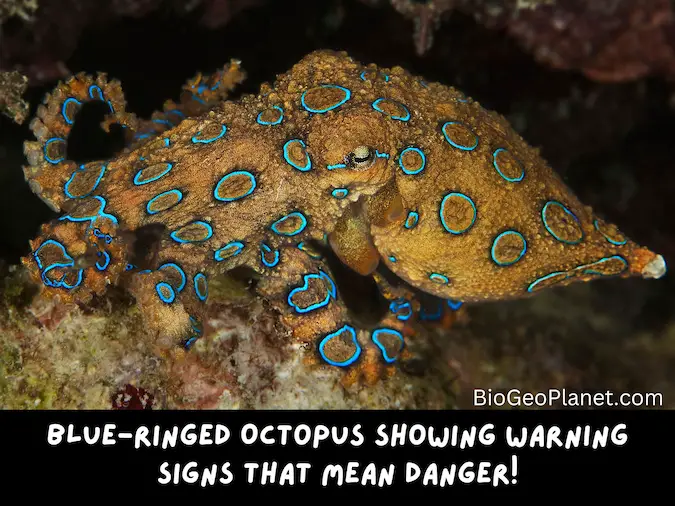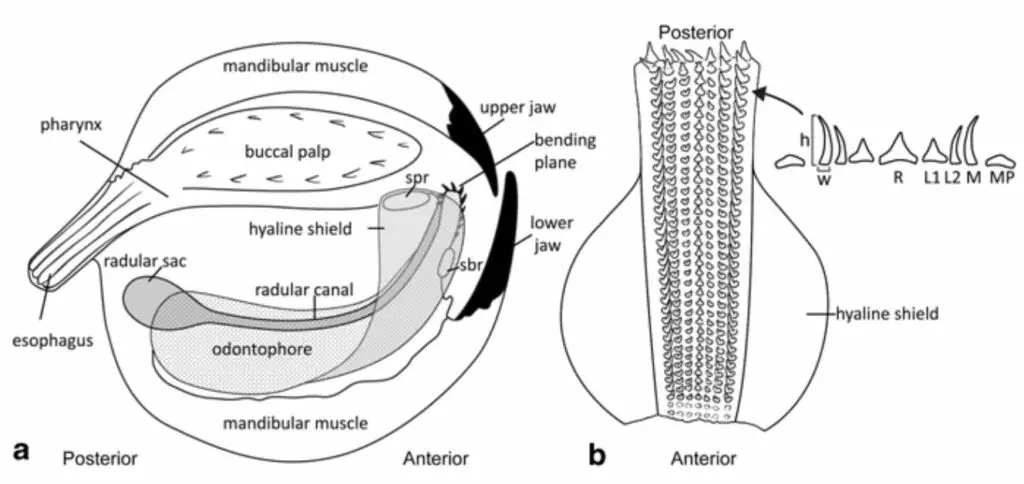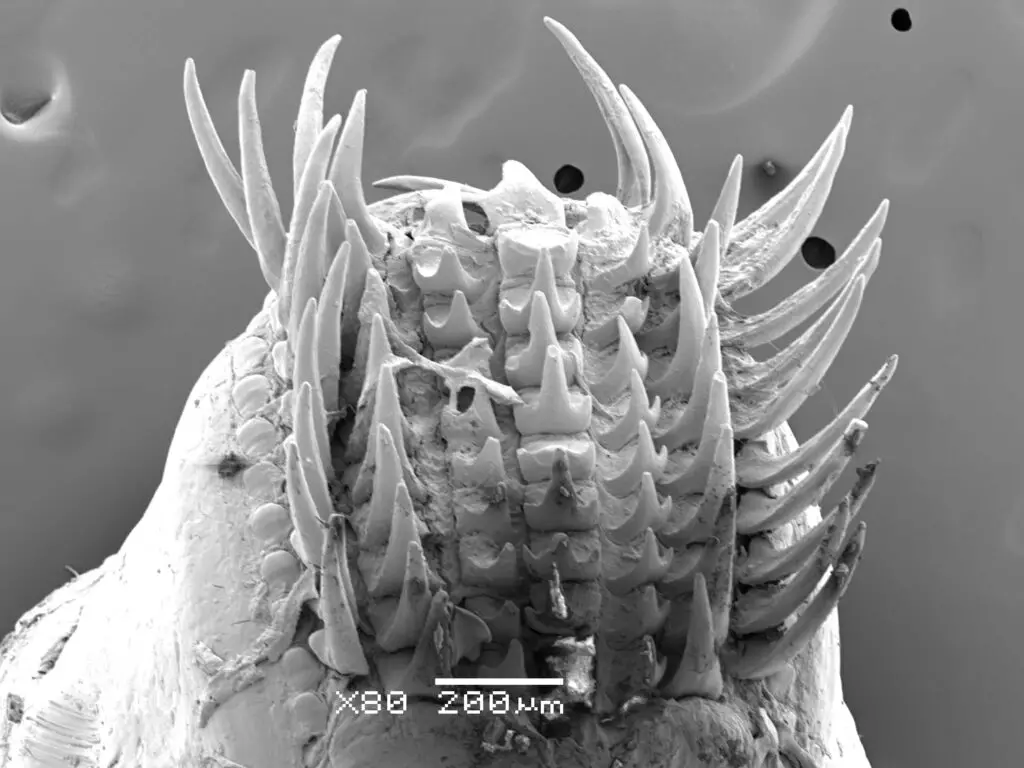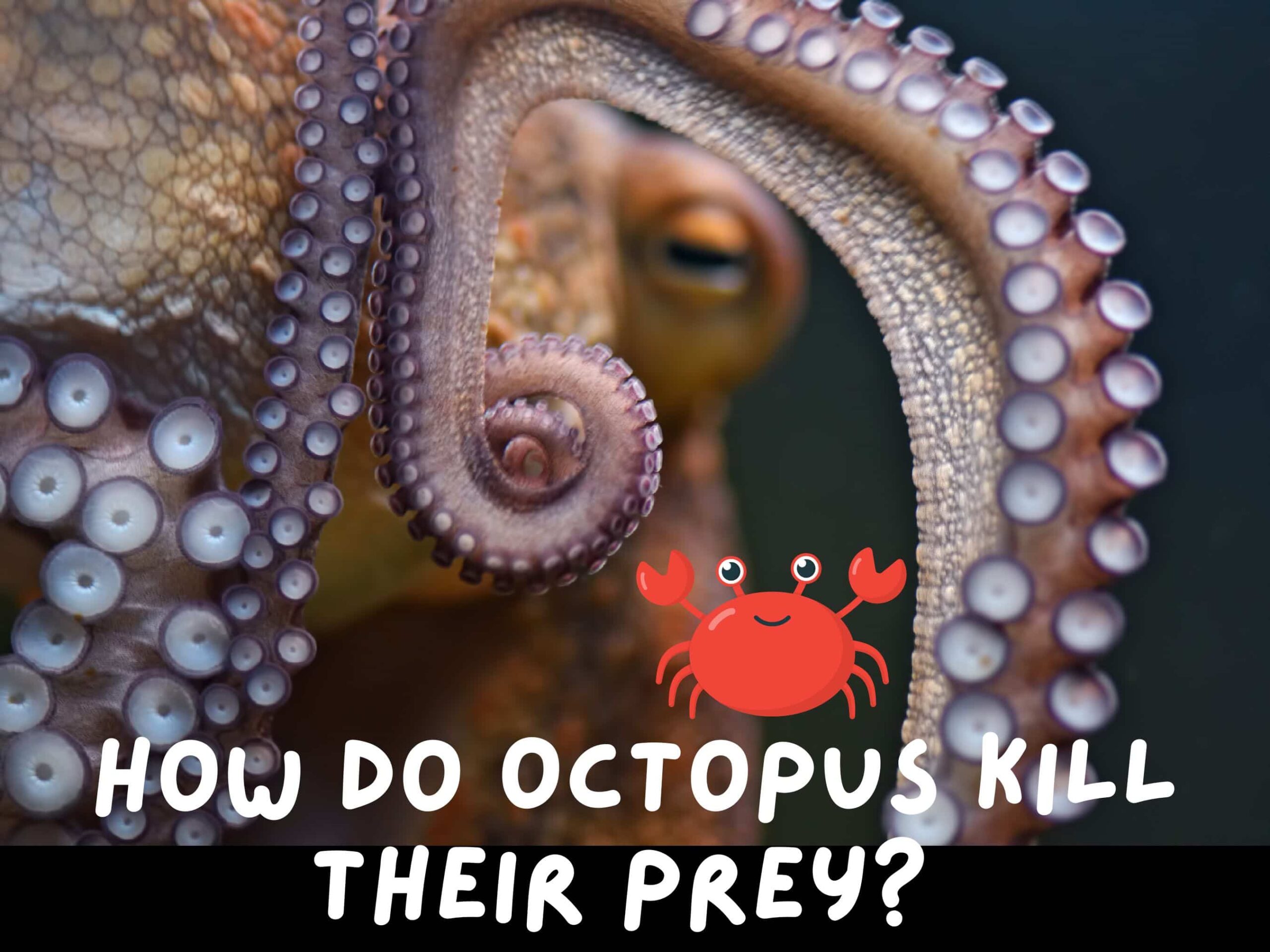Octopuses are stealth hunters that feed on prey such as crabs, lobsters, and shellfish—and even other octopuses. They grasp the prey with strong suckers, enveloping it in their webbed arms while biting and tearing with their powerful parrot-like beaks. They can pierce the shells of prey with their beaks and drill-like radula. Once there is a crack or hole in the shell, octopuses inject venomous saliva into their prey to stun or kill it.
You might think octopuses have it easy, with a complete seafood buffet available for the picking. But slow-moving prey aren’t always a picnic. If you’ve ever tried to open an oyster with your bare hands, you’ll know how difficult it can be.
Crabs and lobsters have sharp, powerful claws for defense! (You’ll know what I mean if you’ve ever been on the receiving end.)
Fortunately for the octopus, it has a secret weapon: venomous saliva.
When an octopus grabs a tasty crab or lobster, it needs to knock the animal out quickly before the claws can do much damage.
Many octopuses inject a venomous cocktail that causes the flesh of its prey to turn to gooey jelly. After they drill through the carapace of a crab or rip open the shell of a clam, the saliva starts to liquify the muscles and organs, allowing the octopus to slurp up the insides.
Some octopuses have a toxin that can paralyze their prey. As the octopus uses its radula and suckers to crack the shell and retrieve the meat, the prey may still be alive but motionless.
Are Octopuses Venomous? Is Their Bite Dangerous to Humans?
All octopuses are venomous, although most octopuses won’t produce enough venom to kill a person. However, there are certain exceptions.
Many cephalopods are venomous, including all octopuses and all cuttlefish, along with certain squid. The only octopus that poses a deadly threat to people is the tiny blue-ringed octopus of Australia and the Asia-Pacific.
When an octopus bites into its prey with its powerful parrot-like beak, it creates a wound with its sharp and horny tongue and releases venom into the wound. The tongue, or radula, has thousands of tiny teeth that are strong enough to drill through the shell of a clam or crab.
The venom is produced in the salivary gland and the digestive process gets started as soon as the venom is injected.
According to research, octopus venom contains proteins that are comparable to those found in various poisonous snakes, porcupinefish, and pufferfish.
What are the Toxic Ingredients of Octopus Venom?
The composition of octopus venom varies depending on the species of octopus. Some octopus venoms contain toxins that can cause paralysis or death in their prey, while others contain compounds that cause pain and numbness or other physical effects.
The specific ingredients of octopus venom can vary widely, but some common components of octopus venom include:
- Neurotoxins: These are toxins that affect the nervous system and can cause paralysis or death. The venom of the blue-ringed octopus (Hapalochlaena species) contains a neurotoxin called tetrodotoxin, which is a potent neurotoxin that can cause paralysis and death in humans.
- Hemolysins: These are toxins that can destroy red blood cells and cause anemia.
- Myotoxins: These are toxins that affect the muscles and can cause paralysis or death.
- Histamines: These are chemicals that cause inflammation and swelling.
- Other enzymes: Octopus venom may also contain other enzymes that can affect the body in various ways.
It is important to note that the specific ingredients of octopus venom can vary widely depending on the species of octopus. Additionally, the effects of octopus venom can depend on the individual animal’s sensitivity to the venom and the amount of venom that is injected.
Can a Blue-ringed Octopus Kill a Human?
This tiny wonder of Australia and the Western Pacific has enough venom to kill roughly 30 people and it is 1,000 times deadlier than cyanide. Victims of this bite may not even know they’ve been exposed until they practically drop dead since the poison is a neurotoxin and shuts down the victim’s lungs.
Fortunately, there have been very few reported deaths from blue-ringed octopus bites in the last several decades. Three deaths have been documented worldwide, two in Australia and one in Singapore.

The blue-ringed octopus has evolved a particularly deadly venom that is much more potent than required to simply kill its prey. As such, it serves both as a defense mechanism and as a means of prey capture.
The venom is very effective for defensive purposes when faced with a large predator. One quick bite is all it takes to paralyze a predator long enough for the octopus to escape.
Blue ringed octopuses are typically shy and will tend to try and hide if disturbed. If it feels threatened, however, it may bite, especially when handled while displaying the striking blue-rings that act as a warning signal.
In humans, the venom can result in nausea, respiratory arrest, heart failure, severe and sometimes total paralysis, blindness, and can lead to death within minutes if not treated.
The saliva of the blue ringed octopus contains Tetrodotoxin (TTX), a strong neuromuscular toxin found in several marine and terrestrial animals including puffer fish and toads.
TTX is a powerful, yet painless, neuromuscular and nerve blocker with negligible effects on heart muscle activity. The only species known to be able to survive exposure is the octopus.
In addition to TTX, the venom contains a potent cocktail of proteins and organic compounds such as histamine, tryptamine, octopamine, taurine, acetylcholine, and dopamine.
Do Octopuses Have Teeth or Tongues? How Do They Eat?
While an octopus doesn’t have teeth or a tongue in the traditional sense, it has a genuine Swiss Army knife of tools inside its mouth.
Instead of teeth and a soft tongue like we humans have, octopuses have very effective tools for ripping open crustaceans and mollusks and devouring their flesh.

Octopuses have a Strong Parrot-like Beak
An octopus possesses a strong parrot-like retractable beak within its mouth. Despite having soft, boneless bodies, octopus beaks are made of chitin, the same material that is found in the exoskeletons of insects, spiders, and crustaceans.
The beak is embedded in a muscular area known as the buccal mass and is useful for pulling meat apart and cracking open shells.
Octopuses have a Drill-like Tongue and Venomous Saliva
Inside the beak the octopus has a barbed, horny tongue, the radula, that it uses to scrape the flesh out of the shell after it has been opened.

Octopuses also possess a tooth-covered organ known as the salivary papilla that is used to drill into shells if the beak and radula aren’t up to the task. The saliva from the papilla contains digestive enzymes and secretions that begin to work on the prey so that it can be devoured like a high-protein shake.
Video of octopus radula
Watch How the Giant Pacific Octopus Eats
In this video, the giant pacific octopus has attacked the crab and the vicious pincers are rendered ineffective by the octopus’s suckers.
Disarmed and immobilized with a minimum of fuss, the crab will not be able to escape this death grip.
The octopus sets to work killing its prey. It doesn’t take long under the folds of its body and arms, its sharp beak is scraping through the underside of the crab’s shell. The shell is pulled in half and eaten clean, and carefully pushed to one side.
All that is left are disembodied remains of the unfortunate crab and a well-satisfied octopus.
How Many Suckers Does an Octopus Have?
An octopus has an astounding 2,240 suction cups in total, or 280 suckers along the length of each of its eight limbs.
Octopus suckers are flexible and smooth but incredibly powerful suction cups, utilized for taste, grip, and scent.
When doing delicate and challenging activities like extracting the meat from crab legs, an octopus can utilize its hundreds of suckers like fingers.
They can even open jars with screw tops!
It takes a lot of brain power to keep all those arms and suckers coordinated and on-task. Octopuses have evolved to become the smartest invertebrates on the planet and have a distributed system of nine brains – one central brain in the head and eight mini-brains, one in each arm.
To learn more about octopus brains and the amazing abilities of these creatures see my article How Smart are Octopuses? (Are Octopuses As Intelligent as Dogs?).
Gulping Down Food Could Strain Your Brain (If You’re an Octopus)
If an octopus tried to gulp down food in big chunks it would give itself a pain in brain.
An octopus’s brain is shaped like a doughnut with the esophagus (the swallowing tube) going through the hole in the middle.
So, the octopus’s food has to go through its brain to get to its stomach!
To avoid this pain in the brain the octopus has to keep the radula moving, chainsawing the food into little pieces and shoving the bits down its throat!
Is Octopus Ink Poisonous?
Even an octopus can die if it gets octopus ink into its gills!
The ink is a seemingly harmless combination of mucus and melanin, the same dark pigment found in skin, hair, and eyes. Tyrosinase is a substance that can impair a predator’s senses of taste and smell.
This mucus mixture may even plug a fish’s gills, causing the animal to suffocate.
Octopuses and other cephalopods use their ink to confound, confuse, and paralyze their predators.
Cephalopod ink doesn’t dissolve in water. After a short time, it turns into grey cobweb-like threads that drift in the water and snag on rocks.
When octopuses and other cephalopods cannot escape their own ink, their respiratory systems may be damaged, causing them to suffocate and die.
Can Octopuses Squeeze Through Small Holes to Capture Prey?
Since the octopus’s entire body can be compressed, it can slither through any hole or crack larger than its beak, which is the only hard bit in its body. This means that even a large octopus can squeeze through a hole that is only 1 inch in diameter.
This allows the octopus to follow prey species through the even tiniest openings and crevices between the rocks.
This Houdini-like trick also gives the octopus the ability to conceal itself in tiny spaces, which is an evolutionary benefit when fleeing from powerful predators with sharp teeth, like sharks or dolphins.
The soft-bodied octopus, however, has developed a method that is even more cunning than that: they are experts at disguising themselves.
Can an Octopus Kill and Eat a Shark?
The Seattle Aquarium has a colony of dogfish sharks, and they were perplexed as to why so many of them were going missing and leaving partially dismembered bodies behind.
Until the staff investigated and discovered what their Giant Pacific Octopus was doing!
After setting up cameras to film the tank overnight they realized that the seemingly innocent octopus was meticulously killing any shark that came close to it. Reaching out with its arms in a lightning fast move the octopus would grab the shark in its suckers and quickly wrap arms around the shark’s body.
Once immobilized the octopus would proceed to take chunks of flesh until it was satiated.
Out in the ocean, however, it would likely be a very different story. Most sharks are larger than octopus, and in most cases, it is the shark that captures and feeds on the octopus.
Octopuses are Normally Gentle and Shy – But Not Always!
Check out this video showing an aggressive Giant Pacific Octopus
There’s lots more to learn about these fascinating creatures!
Want to know more about octopuses?
Check out my series of articles on these fascinating creatures:
How do Octopus Reproduce? (Cannibalistic Sex and a Detachable Male Member)
Why do Octopus have 3 Hearts, 9 Brains, and Blue Blood? Smart Suckers!
How Smart are Octopuses? (Are Octopuses As Intelligent as Dogs?)
Why do Male Octopuses Die after Mating? (How does Octopus Senescence work?)
Can Octopus Arms Grow Back Just as Good As New?
References
Kruta, Isabelle & Landman, Neil & Tanabe, Kazushige. (2015). Ammonoid Radula. 10.1007/978-94-017-9630-9_11.
Check Out Our TOP Articles for Even More Fascinating Creatures
- How do Octopus Reproduce? (Cannibalistic Sex, Detachable Penis)
- Do Jellyfish have Brains? How Can they Hunt without Brains?
- Why are Deep Sea Fish So Weird and Ugly? Warning: Scary Pictures!
- How do Snakes Mate? (Snake Reproduction Videos and Diagrams) Warning – Graphic Images
- Are Komodo Dragons Dangerous? Where Can you See Them?
- How Do Komodo Dragons Reproduce? (Forked Penises, Sperm Optional)
- Koala Brains – Why Being Dumb Can Be Smart (Natural Selection)
- Why do Lions Have Manes? (Do Dark Manes Mean More Sex?)
- How Do Lions Communicate? (Why Do Lions Roar?)
- How Dangerous are Stonefish? Can You Die if You Step on One?
- What Do Animals Do When They Hibernate? How do they Survive?
- Leaf Cutter Ants – Surprising Facts and Adaptations; Pictures and Videos
- Irukandji Jellyfish Facts and Adaptations; Can They Kill You? Are they spreading?
- How to See MORE Wildlife in the Amazon: 10 Practical Tips
- Is it Safe to go on Safari with Africa’s Top Predators and Most Dangerous Animals?
- What to Do if You Encounter a Bullet Ant? World’s Most Painful Stinging Insect!
- How Do Anglerfish Mate? Endless Sex or Die Trying!
- How Smart are Crocodiles? Can They Cooperate, Communicate…Use Tools?
- How Can We Save Our Oceans? With Marine Sanctuaries!
- Why Are Male Birds More Colorful? Ins and Outs of Sexual Selection Made Easy!
- Why is the Cassowary the Most Dangerous Bird in the World? 10 Facts
- How Do African Elephants Create Their Own Habitat?
- What is Killing Our Resident Orcas? Endangered Killer Whales
- Why are Animals of the Galapagos Islands Unique?
- Where Can You See Wild Lemurs in Madagascar? One of the Best Places
- Where Can You see Lyrebirds in the Wild? the Blue Mountains, Australia
- Keeping Mason Bees as Pets
- Why do Flamingos have Bent Beaks and Feed Upside Down?
- Why are Hippos Dangerous? (Do They Attack People?)

